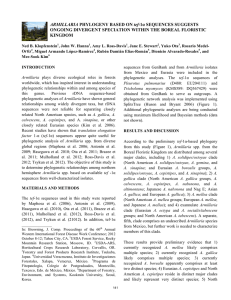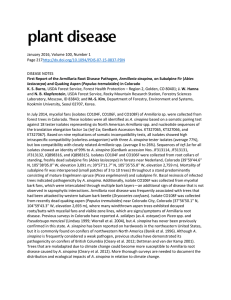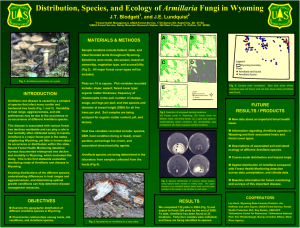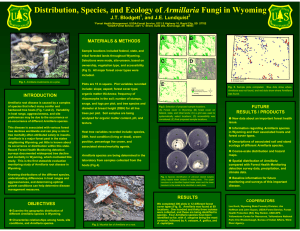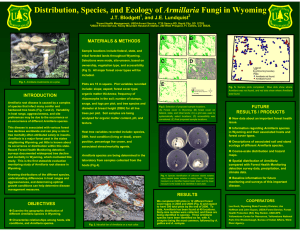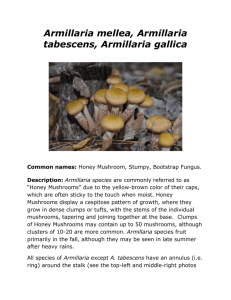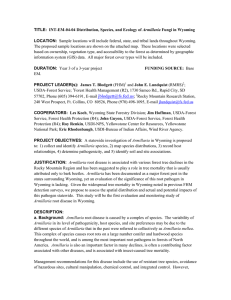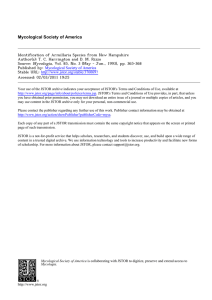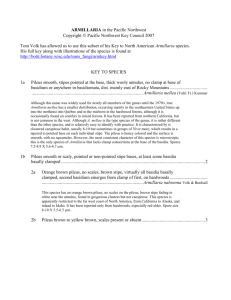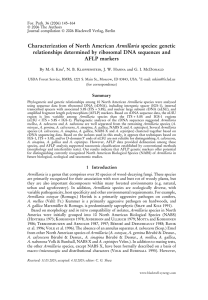DNA-based Identification and Phylogeny of North Armillaria !
advertisement
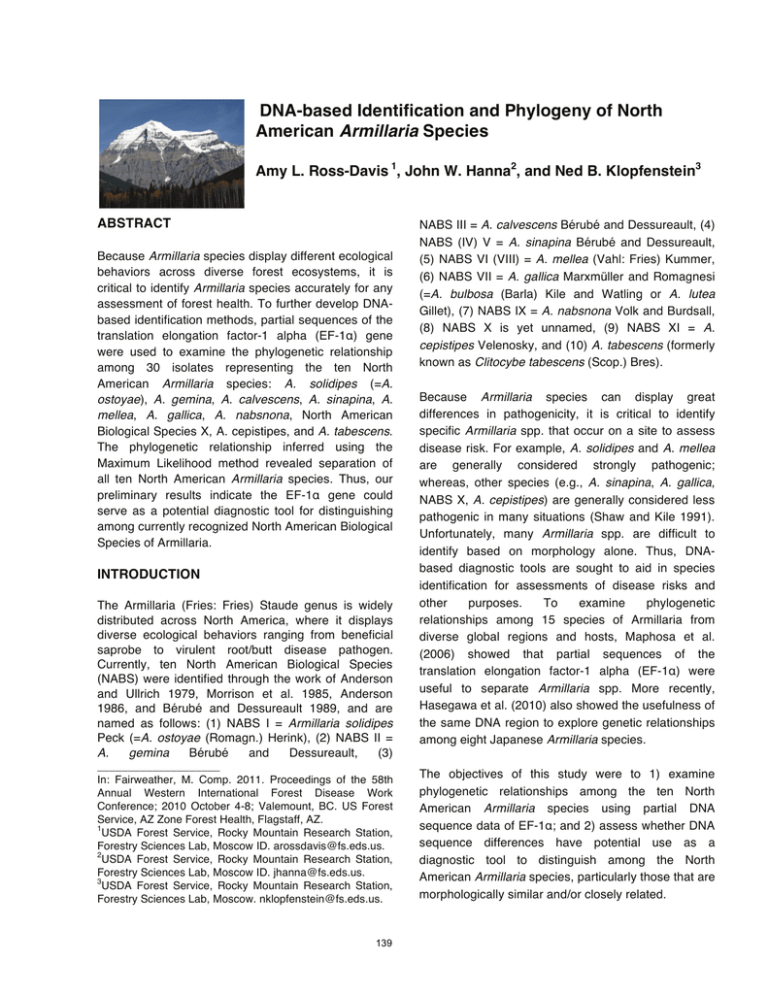
! DNA-based Identification and Phylogeny of North American Armillaria Species Amy L. Ross-Davis 1, John W. Hanna2, and Ned B. Klopfenstein3 ABSTRACT NABS III = A. calvescens Bérubé and Dessureault, (4) NABS (IV) V = A. sinapina Bérubé and Dessureault, (5) NABS VI (VIII) = A. mellea (Vahl: Fries) Kummer, (6) NABS VII = A. gallica Marxmüller and Romagnesi (=A. bulbosa (Barla) Kile and Watling or A. lutea Gillet), (7) NABS IX = A. nabsnona Volk and Burdsall, (8) NABS X is yet unnamed, (9) NABS XI = A. cepistipes Velenosky, and (10) A. tabescens (formerly known as Clitocybe tabescens (Scop.) Bres). Because Armillaria species display different ecological behaviors across diverse forest ecosystems, it is critical to identify Armillaria species accurately for any assessment of forest health. To further develop DNAbased identification methods, partial sequences of the translation elongation factor-1 alpha (EF-1α) gene were used to examine the phylogenetic relationship among 30 isolates representing the ten North American Armillaria species: A. solidipes (=A. ostoyae), A. gemina, A. calvescens, A. sinapina, A. mellea, A. gallica, A. nabsnona, North American Biological Species X, A. cepistipes, and A. tabescens. The phylogenetic relationship inferred using the Maximum Likelihood method revealed separation of all ten North American Armillaria species. Thus, our preliminary results indicate the EF-1α gene could serve as a potential diagnostic tool for distinguishing among currently recognized North American Biological Species of Armillaria. Because Armillaria species can display great differences in pathogenicity, it is critical to identify specific Armillaria spp. that occur on a site to assess disease risk. For example, A. solidipes and A. mellea are generally considered strongly pathogenic; whereas, other species (e.g., A. sinapina, A. gallica, NABS X, A. cepistipes) are generally considered less pathogenic in many situations (Shaw and Kile 1991). Unfortunately, many Armillaria spp. are difficult to identify based on morphology alone. Thus, DNAbased diagnostic tools are sought to aid in species identification for assessments of disease risks and other purposes. To examine phylogenetic relationships among 15 species of Armillaria from diverse global regions and hosts, Maphosa et al. (2006) showed that partial sequences of the translation elongation factor-1 alpha (EF-1α) were useful to separate Armillaria spp. More recently, Hasegawa et al. (2010) also showed the usefulness of the same DNA region to explore genetic relationships among eight Japanese Armillaria species. INTRODUCTION The Armillaria (Fries: Fries) Staude genus is widely distributed across North America, where it displays diverse ecological behaviors ranging from beneficial saprobe to virulent root/butt disease pathogen. Currently, ten North American Biological Species (NABS) were identified through the work of Anderson and Ullrich 1979, Morrison et al. 1985, Anderson 1986, and Bérubé and Dessureault 1989, and are named as follows: (1) NABS I = Armillaria solidipes Peck (=A. ostoyae (Romagn.) Herink), (2) NABS II = A. gemina Bérubé and Dessureault, (3) ____________________ In: Fairweather, M. Comp. 2011. Proceedings of the 58th Annual Western International Forest Disease Work Conference; 2010 October 4-8; Valemount, BC. US Forest Service, AZ Zone Forest Health, Flagstaff, AZ. 1 USDA Forest Service, Rocky Mountain Research Station, Forestry Sciences Lab, Moscow ID. arossdavis@fs.eds.us. 2 USDA Forest Service, Rocky Mountain Research Station, Forestry Sciences Lab, Moscow ID. jhanna@fs.eds.us. 3 USDA Forest Service, Rocky Mountain Research Station, Forestry Sciences Lab, Moscow. nklopfenstein@fs.eds.us. ! The objectives of this study were to 1) examine phylogenetic relationships among the ten North American Armillaria species using partial DNA sequence data of EF-1α; and 2) assess whether DNA sequence differences have potential use as a diagnostic tool to distinguish among the North American Armillaria species, particularly those that are morphologically similar and/or closely related. ! ! MATERIALS AND METHODS RESULTS Three isolates of each North American Armillaria species were included in this study (figure 1). Isolates were incubated in the dark at 21°C for approximately 2.5 weeks on 0.20 μm-pore, nylon membranes (Millipore, County Cork, Ireland) atop 3 percent malt agar. DNA was extracted from isolates using the DNeasy Plant Mini Kit (Quiagen Inc., Valencia, CA, USA) according to the manufacturerʼs protocol with an additional wash of 100 percent ethanol prior to elution. DNA was quantified using a NanoDrop™2000 (Wilmington, DE, USA) and stored at -20°C. Phylogenetic analysis of the partial EF-1α gene revealed five major clades: 1) a basal clade of A. tabescens, 2) a clade containing A. gemina, A. solidipes (= A. ostoyae), A. mellea, and A. sinapina, 3) a clade containing A. nabsnona and A. cepistipes, 4) a clade containing NABS X, and 5) a clade containing A. calvescens and A. gallica (figure 1). Partial sequence data for the EF-1α gene delineated all ten North American species of Armillaria into separate clades or subclades, but A. gallica isolates were not comprised within a single subclade. PCRAmplification and DNA Sequencing To amplify the EF-1α gene, each 50-μl polymerase chain reaction mixture contained 5 μl (equating to 35 to 520 ng) template DNA, omitted for negative control, 2.5 U Taq polymerase (Applied Biosystems, Inc, Foster City, CA, USA), PCR reaction buffer (supplied with Taq enzyme), 4 mM MgCl2, 200 μM dNTPs, and 0.5 μM of each primer (Forward: CGT GAC TTC ATC AAG AAC ATG and Reverse: CCG ATC TTG TAG ACG TCC TG (Wendland and Kothe 1997 in Kauserud and Schumacher 2001)). Thermal cycler conditions were as follows: 94°C for 2 min; 30 cycles of 94°C for 30 s, 57°C for 30 s, 72 °C for 1 min and 30 s; and 72 °C for 7 min. Sequences were edited and aligned manually with BioEdit software (Hall 1999). To minimize errors, both forward and reverse directions of the region were edited and aligned and two researchers performed all sequence editing independently. Polymorphisms were coded with the IUPAC codes for ambiguous nucleotides. CLADE 1: The basal clade is comprised entirely of A. tabescens, the only exannulate species of Armillaria in North America. It is pathogenic on hardwoods in eastern North America, particularly on oaks and fruit trees in the Southeast. CLADE 2: This clade consists of the aggressive pathogens A. solidipes (= A. ostoyae) and A. mellea as well as A. sinapina, which has been associated with A. solidipes disease centers as a secondary invader (Dettman and van der Kamp 2001), and A. gemina, which is similar to A. solidipes (Bérubé and Dessureault 1989; Kim et al. 2006). CLADE 3: A. nabsnona and A. cepistipes, saprobes or occasionally weak pathogens found on hardwoods in the west, comprise the third clade. CLADE 4: The unnamed NABS X, known only from British Columbia, Washington, Oregon, California and Idaho, comprises the fourth clade. Phylogenetic Analysis The phylogenetic relationship was inferred using the Maximum Likelihood method based on the TamuraNei model. The 50 percent majority-rule, consensus tree inferred from 1000-bootstrap replicates was taken to represent the relationship among species. The percentage of replicate trees in which the associated species clustered together in the bootstrap test is shown next to the branches. A discrete Gamma distribution was used to model evolutionary rate differences among sites (four categories [+G, parameter = 1.0993]). The analysis involved 34 nucleotide sequences, since two different copies of the gene were present in four of the 30 isolates. All positions containing gaps and missing data were eliminated. There were 449 positions in the final dataset. Analyses were conducted in MEGA (Tamura et al. 2007). ! CLADE 5: This final clade is comprised of the morphologically indistinguishable species A. calvescens and A. gallica. Both species are found east of the Rockies primarily on hardwoods, but A. gallica is also found west of the Rockies. Armillaria gallica does not form a well-defined subclade. These data, as well as other sequence and AFLP data (Kim et al. 2006, Hanna et al. 2007), suggest that A. gallica is a genetically diverse species that may comprise multiple genetically distinct groups. DISCUSSION DNA-sequence-based identification of Armillaria is an essential step to monitor and predict Armillaria root disease in forest ecosystems. Previously, Kim et al. (2006) reported that rDNA sequence data are not sufficient to confirm species identification among the ! ! closely related species A. calvescens, A. sinapina, A. gallica, and A. cepistipes. Other molecular characteristics, such as DNA content can help to identify some species, but facilities to determine DNA content are not widely available (Kim et al. 2000). mating/pairing tests of more isolates is required for verification of the utility of this region as a diagnostic tool. The region may also be useful for phylogenetic studies, particularly when combined with sequence data from additional genes. The results from this study show that the single-copy EF-1α gene could potentially serve as a diagnostic tool to distinguish among all ten North American species of Armillaria. However, further work associated with morphological characterization and This work is part of an on-going study to 1) examine relationships among the North American Armillaria species using sequence data from a variety of loci; and 2) confirm the validity of sequence for use as a diagnostic tool to distinguish among species. Figure 1—50 percent majority-rule, consensus phylogenetic tree based on partial EF-1α sequences of ten North American species of Armillaria. ! ! ! REFERENCES Maphosa, L., Wingfield, B.D., Coetzee, M.P.A., Mwenje, E., Wingfield, M.J. 2006. Phylogenetic relationships among Armillaria species inferred from partial elongation factor 1alpha DNA sequence data. Australasian Plant Pathology 35:513-520. Morrison, D.J., Chu, D., Johnson, A.L.S. 1985. Species of Armillaria in British Columbia. Canadian Journal of Plant Pathology. 7:242-246. Shaw, C.G.,II, Kile, G.A. eds. 1991. Armillaria root disease. Agricultural Handbook No. 691. Washington, DC: USDA Forest Service. 233 p. Tamura, K., Dudley, J., Nei, M., Kumar, S. 2007. MEGA4: Molecular Evolutionary Genetics Analysis (MEGA) software version 4.0. Molecular Biology and Evolution 24:1596-1599. Anderson, J.B., Ullrich, R.C. 1979. Biological species of Armillaria in North America. Mycologia 71:402-414. Anderson, J.B. 1986. Biological species of Armillaria in North America: redesignation of groups IV and VIII and enumeration of voucher strains for other groups. Mycologia 78:837-839. Bérubé, J.A., Dessureault, M. 1989. Morphological studies of the Armillaria mellea complex: Two new species, A. gemina and A. calvescens. Mycologia 81:216-225. Dettman, J.R., van der Kamp, B.J. 2001. The population structure of Armillaria ostoyae and Armillaria sinapina in the central interior of British Columbia. Canadian Journal of Botany 79:600-611. Hall, T.A. 1999. BioEdit: a user-friendly biological sequence alignment editor and analysis program for Windows 95/98/NT. Nucleic Acids Symposium Series 41:95-98. Hanna, J.W., Klopfenstein, N.B., Kim, M.-S., McDonald, G.I., Moore, J.A. 2007. Phylogeographic patterns of Armillaria ostoyae in the western United States. Forest Pathology 37:192-216. Hasegawa, E., Ota, Y., Hattori, T., Kikuchi, T. 2010. Sequence-based identification of Japanese Armillaria species using the elongation factor-1 alpha gene. Mycologia 102:898-910. Kauserud, H., Schumacher, T. 2001. Outbreeding or inbreeding: DNA markers provide evidence for type of reproductive mode in Phellinus nigrolimitatus (Basidiomycota). Mycological Research 6:676-683. Kim, M.-S., Klopfenstein, N.B., McDonald, G.I., Arumuganathan, K., Vidaver, A.K. 2000. Characterization of North American Armillaria species by nuclear DNA content and RFLP analysis. Mycologia 92:874-883. Kim, M.-S., Klopfenstein, N.B., Hanna, J.W., McDonald, G.I. 2006. Characterization of North American Armillaria species: genetic relationships determined by ribosomal DNA sequences and AFLP markers. Forest Pathology 36:145-164. ! !
